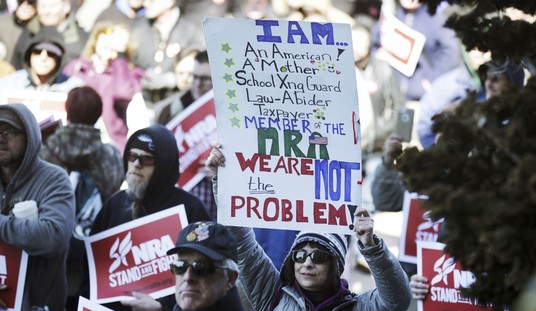 I was recently teaching a concealed carry class here in Arizona, and I was asked what gun I would recommend for daily carry. I gave my standard answer; ‘whatever you feel happy about carrying.’ On being pressed, I explained that, despite the claims of those who insisted on carrying heavy artillery wherever they went, the gun didn’t really matter; it was the person behind the gun who counted.
I was recently teaching a concealed carry class here in Arizona, and I was asked what gun I would recommend for daily carry. I gave my standard answer; ‘whatever you feel happy about carrying.’ On being pressed, I explained that, despite the claims of those who insisted on carrying heavy artillery wherever they went, the gun didn’t really matter; it was the person behind the gun who counted.
My thinking behind this is simple. You may have the finest example of the gunmaker’s art for your carry weapon. The magazine may hold 10, 13, or 15 rounds of good ammo, but if you leave it behind one day, it’s of no use at all.
I reached into my shooting bag and pulled out the pistol I carry most. It’s a Colt 1903 Model M in .32ACP, and it’s loaded with 8 rounds of Glaser Safety Slugs.
I can already hear some of you Magnumaniacs saying, “He’s lost his mind; nobody uses a .32 Auto for a serious defense gun.” This may be true for you, but it’s my life and it’s my decision. The .32 Auto is, after all, the only pistol round known to have started a war. A Browning Model 1900 .32 was used by Bosnian nationalist Gavrilo Princip to assassinate the heir to the Austro-Hungarian throne in Sarajevo in 1914, which started the First World War.
The Colt 1903 has also appeared in some unusual places, too. It’s the object that links together movie star Humphrey Bogart, criminals Bonnie and Clyde, John Dillinger, and military genius General George S. Patton. Think about it and you’ll see the connection. When Rick Blaine (Bogart) holds Captain Renault (Claude Rains) at gunpoint (“Not so fast, Louis”) in the classic film “Casablanca,” what gun does he have in his hand? A Colt 1903. An inventory of the weapons found in Bonnie and Clyde’s V-8 Ford after they had been ambushed by Texas Ranger Captain Frank Hamer included one of these. John Dillinger had one, and pictures of General George S. Patton showed him wearing one during WW2, which had the 3 stars of his rank embellished on the grips.
It may seem a little strange to some of you that I’m using a gun first introduced in 1903 as an everyday carry piece. Below are some of the reasons. First off, it’s light, weighing only 24 ounces fully loaded. This sits well against a Glock 19 at 28 ounces, and a Browning High Power or Colt Government Model at just over 2 pounds.
Next is the question of concealability. Colt’s early advertising of the Model 1903 stressed the compactness of the gun, which led to the advertising slogan, “Flat as a Book.” The 1903 measures a mere ¾” at the widest point of its slide. Set this against the Glock, at 1″, and the Colt Government at a fraction less.
Then, there’s its ergonomics. The gun feels slick in the hand just like a well-worn bar of soap. There are no sharp protrusions to slice the hand and no sharp corners to snag on a jacket or shirt.
I feel confident that the eight rounds of Glaser Safety Slugs that I use in the gun will prove more than adequate if I ever have to use the gun in a defensive situation. With the bullet traveling at 1,400 feet per second, delivering 174 foot pounds of energy, I’m pretty confident that there’d be no further talk of the ‘anemic’ .32 Auto.
I’m also a bit skeptical about ‘magic bullets’ and the eternal arguments about one shot stop statistics. If I’m ever unfortunate enough to get involved in a life-threatening attack, I’ll shoot. If one shot doesn’t stop my opponent, I’ll continue shooting until the threat is neutralized.
The gun was designed, as were so many other Colt guns, by the American Colossus of firearms, John Browning, and was first sold in June 1903. Manufacture continued until 1945, during which time a number of minor modifications were made. These included the reduction in barrel length from 4″ to 3.8″, elimination of the barrel bushing and, in late 1926, the addition of a magazine safety.
Altogether, some 772,215 Model 1903 .32 auto pistols were sold by the time production ceased in 1945. My own Model M was made in 1923 and was picked up at a gun show for the bargain price of $120. It was supplied with an original magazine and wore a pair of checkered wooden grips which were badly scarred. The bluing was almost gone, so I had it vapor blasted then hard chromed. When it was returned to me a few weeks later, I was amazed at the difference. The smooth, slim lines of the gun had been enhanced by the matte chrome finish. A set of original black grips, bought at a gun show, made an elegant contrast. The design of the Model M is timeless; so much so that people who saw it asked if it was a new gun from Colt. They were amazed when I told them that the design of it pre-dated by eight years the Colt 1911 .45 auto.

Finding a holster to fit the gun was no real problem. When carrying concealed, the gun was worn in a Galco ‘Jak Slide,’ that was originally designed for the SIG P230. This is a simple belt slide holster, worn on the strong side just behind the hip bone and is almost invisible when worn under a short jacket. For deep concealment, I selected a Galco ‘Underwraps’ bellyband, which allows all-day comfortable carry under a shirt. I wear this at solar plexus level, with the gun’s butt just to the left of my mid-section. The gun is completely hidden with a dark or patterned shirt.
The Model 1903 is ideal for carrying in Condition One; cocked and locked. Having no external hammer, the only indication that the gun is loaded is the grip safety, which protrudes after the slide is racked to chamber a round. The tiny slide safety is easily applied, and just as easily released by wiping the thumb downwards during the draw. Another advantage is that the gun is a single action. Therefore the trigger pull is a fairly decent 5 pounds, which stands up well against some newer of the double action designs that seem to require the assistance of an 8-mule team to pull the trigger!
When I first began to use the pistol, I found that the toe of the magazine’s base plate protruded just far enough forward to cause it to dig painfully into my pinkie finger. This was soon cured, by simply grinding off enough metal from the base plate so that the magazine fitted flush with the bottom of the frame.
Recoil was amazingly light, even when FMJ and hollow-point loads from Fiocchi were used, which seem a little hotter than similar offerings from American ammo manufacturers. Accuracy from the 3.8″ barrel was more than adequate. When shooting at combat distances, it was easy to keep all eight shots in the ‘A’ zone of an IPSC target at 20 feet, even when shooting one handed. I tested a number of other loads, including Glaser Safety Slugs. I live in Arizona where lightweight attire is the norm, so I would have no fears of these bullets breaking up on a heavy coat or leather jacket. Winchester Silvertip and regular hardball were also tested, and all of them were digested by the gun perfectly.
The sights on the Model M are typical of the era: snagproof, but almost impossible to see in anything but perfect lighting conditions. The hard chrome finish on the gun also didn’t help in any way, as the front sight disappeared against light-colored targets. To overcome this problem, I painted a blob of fluorescent orange paint on the front sight. This made it stand out like a glowing beacon under any lighting conditions. When shooting the gun, both one-handed and in a normal two-handed grip, I found that the point shooting method worked for me. In normal target shooting, the gun is held at eye level with the front sight centered in the rear sight notch. With point shooting techniques, the gun is pushed straight out in front of you at chest level, with the eyes focused on the target and the gun. This worked for me, and I also found that I could still see the front sight in my peripheral vision. I found that my natural point index brought the barrel slightly under the target when practicing with an empty gun. With a little practice, I soon managed to center my hits on the target every time, by simply cranking my wrist upwards a little. It only took a few magazines full to build enough muscle memory to make this instinctive.
This technique will work with any type of handgun and is well worth adding to your repertoire of shooting skills.
There are still a huge number of Model 1903 Colts around in both .32ACP and .380. They can be picked up at fairly reasonable prices if you’re prepared to accept one that needs refinishing.
They are definitely part of America’s firearms heritage. They stand up well, or even better, against some of today’s offerings.








Join the conversation as a VIP Member